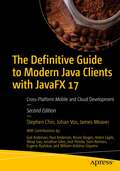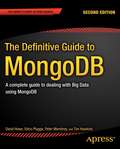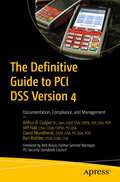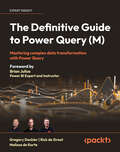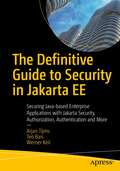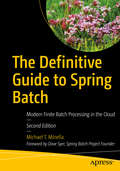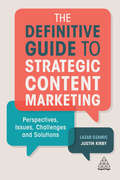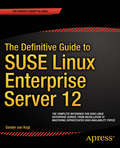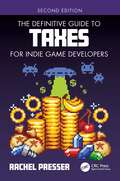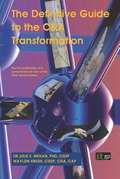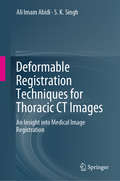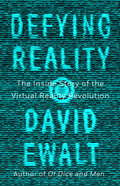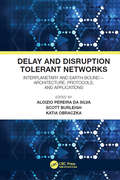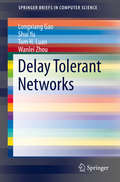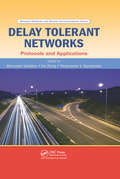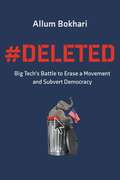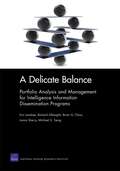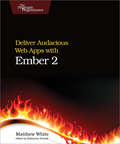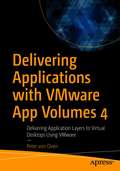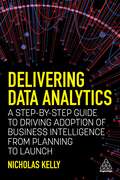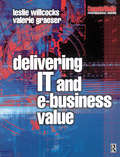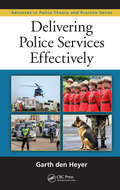- Table View
- List View
The Definitive Guide to Modern Java Clients with JavaFX 17: Cross-Platform Mobile and Cloud Development
by Stephen Chin Johan Vos James WeaverBuild enhanced visual experiences and design and deploy modern, easy-to-maintain, client applications across a variety of platforms. This book will show you how these applications can take advantage of JavaFX’s latest user interface components, 3D technology, and cloud services to create immersive visualizations and allow high-value data manipulation. The Definitive Guide to Modern Java Clients with JavaFX 17 is a professional reference for building Java applications for desktop, mobile, and embedded in the Cloud age. It offers end-to-end coverage of the latest features in JavaFX 17 and Java 17. Among the many new or updated JavaFX features covered are the FX Robot API, for simulating user interaction; customized step repeat timing for the Spinner control; Marlin FX; the ColorPicker color palette; and the GetCenter method. After reading this book, you will be equipped to upgrade legacy client applications, develop cross-platform applications in Java, and build enhanced desktop and mobile native clients. What You Will Learn: Create modern client applications in Java using the latest JavaFX 17 and Java 17 LTS Build enterprise clients that will enable integration with existing cloud services Use advanced visualization and 3D features Deploy on desktop, mobile, and embedded devices Who This Book Is For: Professional Java developers who are interested in learning the latest client Java development techniques to fill out their skills set.
The Definitive Guide to MongoDB
by Tim Hawkins David Hows Peter Membrey Eelco PluggeMongoDB, a cross-platform NoSQL database, is the fastest-growing new database in the world. MongoDB provides a rich document orientated structure with dynamic queries that you'll recognize from RDMBS offerings such as MySQL. In other words, this is a book about a NoSQL database that does not require the SQL crowd to re-learn how the database world works MongoDB has reached 1. 0 and already boasts 50,000+ users. The community is strong and vibrant and MongoDB is improving at a fast rate. With scalable and fast databases becoming critical for today's applications, this book shows you how to install, administer and program MongoDB *without* pretending SQL never existed. What you'll learn * Set up MongoDB on all major platforms, including Linux and Cloud platforms * Model data within a document-oriented database * Work with your data using non-SQL commands * Write applications using MongoDB's PHP API * Optimize MongoDB * Master MongoDB administration, including replication Who this book is for This book will appeal to everyone with some experience in database administration, and provides the entry point for those of us who don't want to hear about database theory but still need to implement a NoSQL-based database. PHP developers will also profit from this book, since it will add an important NoSQL database to their toolkit. Table of Contents * Introduction to MongoDB * Installing MongoDB * The Data Model * Working with Data * GridFS * PHP and MongoDB * Python and MongoDB * Creating a Blog Application with the PHP Driver * Database Administration * Optimization * Replication * Sharding
The Definitive Guide to PCI DSS Version 4: Documentation, Compliance, And Management
by Arthur B. Cooper Jr. Jeff Hall David Mundhenk Ben RothkeThis book is your go-to reference on how to achieve PCI compliance. With more than 400 PCI requirements, the updated PCI Data Security Standard (PCI DSS) v4.0 does not detail the specific documentation that a PCI auditor—known as a Qualified Security Assessor (QSA)—needs to know. This book is the first reference to detail the specific documentation needed for every PCI requirement. The authors provide real-world examples of complying with the 12 main PCI requirements and clarify many of the gray areas within the PCI DSS.Any merchant or service provider that stores, processes, or transmits credit card data must comply with the PCI Data Security Standard. PCI DSS 1.0 was first published in 2004, yet many of those tasked with PCI compliance still encounter difficulties when trying to make sense of it. PCI DSS version 4 was published in March 2022, and at 360 pages, it has numerous additional requirements, leaving many people struggling to know what they need to do to comply.PCI DSS v4.0 has a transition period in which PCI DSS version 3.2.1 will remain active for two years from the v4.0 publication date. Although the transition period ends on March 31, 2024, and may seem far away, those tasked with PCI compliance will need every bit of the time to acquaint themselves with the many news updates, templates, forms, and more, that PCI v4.0 brings to their world. What You’ll Learn Know what it takes to be PCI compliantUnderstand and implement what is in the PCI DSSGet rid of cardholder dataEverything you need to know about segmenting your cardholder data networkKnow what documentation is needed for your PCI compliance effortsLeverage real-world experience to assist PCI compliance work Who This Book Is For Compliance managers and those tasked with PCI compliance, information security managers, internal auditors, chief security officers, chief technology officers, and chief information officers. Readers should have a basic understanding of how credit card payment networks operate, in addition to basic security concepts.
The Definitive Guide to Power Query (M): Mastering complex data transformation with Power Query
by Gregory Deckler Rick de Groot Melissa de KorteLearn how to use the Power Query M formula language and its functions effectively for better data modeling and impactful business intelligence reports. Purchase of the print or Kindle book includes a free PDF eBookKey FeaturesGet comprehensive coverage of fundamental and advanced Power Query conceptsGain hands-on experience with practical examples based on real-world problemsDelve into the intricacies of Power Query M language for enhanced data manipulationBook DescriptionData transformation is a critical step in building data models and business intelligence reports. Power Query is an invaluable tool for anyone who wants to master data transformation, and this book will equip you with the knowledge and skills to make the most of it. The Definitive Guide to Power Query (M) will help you build a solid foundation in the Power Query M language. As you progress through the chapters, you'll learn how to use that knowledge to implement advanced concepts and data transformations. This will set the stage for an uncompromisingly thorough exploration of the Power Query M Language. You'll also get to grips with optimizing performance, handling errors, and implementing efficient data processing techniques. As this is a hands-on guide, the practical examples in the chapters will help you gain the skills to apply Power Query to real-world problems and improve your data analysis capabilities. By the end of this book, you will be able to leverage all of Power Query's remarkable capabilities for data transformation.What you will learnGain a strong understanding of Power Query fundamentalsMaster various functions within Power Query to perform complex data operationsAcquire knowledge about values, types, and control structures in Power QueryDevelop proficiency in error handling techniquesLearn performance optimization strategies for Power QueryApply what you’ve learned to real-world scenarios, including common troublesome patternsWho this book is forThis book is for business analysts, business intelligence professionals, and power business users working with data who want to add Power Query mastery to their resume. This book will be beneficial for anyone who wants to automate their process of data cleaning and save huge amount of time. Having some basic experience in Power Query is recommended.
The Definitive Guide to Security in Jakarta EE: Securing Java-based Enterprise Applications with Jakarta Security, Authorization, Authentication and More
by Arjan Tijms Teo Bais Werner KeilRefer to this definitive and authoritative book to understand the Jakarta EE Security Spec, with Jakarta Authentication & Authorization as its underlying official foundation. Jakarta EE Security implementations are discussed, such as Soteria and Open Liberty, along with the build-in modules and Jakarta EE Security third-party modules, such as Payara Yubikey & OIDC, and OmniFaces JWT-Auth.The book discusses Jakarta EE Security in relation to SE underpinnings and provides a detailed explanation of how client-cert authentication over HTTPS takes place, how certifications work, and how LDAP-like names are mapped to caller/user names. General (web) security best practices are presented, such as not storing passwords in plaintext, using HTTPS, sanitizing inputs to DB queries, encoding output, and explanations of various (web) attacks and common vulnerabilities are included.Practical examples of securing applications discuss common needs such as letting users explicitly log in, sign up, verify email safely, explicitly log in to access protected pages, and go direct to the log in page. Common issues are covered such as abandoning an authentication dialog halfway and later accessing protected pages again.What You Will LearnKnow what Jakarta/Java EE security includes and how to get started learning and using this technology for today's and tomorrow's enterprise Java applicationsSecure applications: traditional server-side web apps built with JSF (Faces) as well as applications based on client-side frameworks (such as Angular) and JAX-RSWork with the daunting number of security APIs in Jakarta EEUnderstand how EE security evolvedWho This Book Is ForJava developers using Jakarta EE and writing applications that need to be secured (every application). Basic knowledge of Servlets and CDI is assumed. Library writers and component providers who wish to provide additional authentication mechanisms for Jakarta EE also will find the book useful.
The Definitive Guide to Spring Batch: Modern Finite Batch Processing in the Cloud
by Michael T. MinellaWork with all aspects of batch processing in a modern Java environment using a selection of Spring frameworks. This book provides up-to-date examples using the latest configuration techniques based on Java configuration and Spring Boot. The Definitive Guide to Spring Batch takes you from the “Hello, World!” of batch processing to complex scenarios demonstrating cloud native techniques for developing batch applications to be run on modern platforms. Finally this book demonstrates how you can use areas of the Spring portfolio beyond just Spring Batch 4 to collaboratively develop mission-critical batch processes.You’ll see how a new class of use cases and platforms has evolved to have an impact on batch-processing. Data science and big data have become prominent in modern IT and the use of batch processing to orchestrate workloads has become commonplace. The Definitive Guide to Spring Batch covers how running finite tasks on cloud infrastructure in a standardized way has changed where batch applications are run.Additionally, you’ll discover how Spring Batch 4 takes advantage of Java 9, Spring Framework 5, and the new Spring Boot 2 micro-framework. After reading this book, you’ll be able to use Spring Boot to simplify the development of your own Spring projects, as well as take advantage of Spring Cloud Task and Spring Cloud Data Flow for added cloud native functionality.Includes a foreword by Dave Syer, Spring Batch project founder.What You'll LearnDiscover what is new in Spring Batch 4 Carry out finite batch processing in the cloud using the Spring Batch projectUnderstand the newest configuration techniques based on Java configuration and Spring Boot using practical examplesMaster batch processing in complex scenarios including in the cloud Develop batch applications to be run on modern platforms Use areas of the Spring portfolio beyond Spring Batch to develop mission-critical batch processesWho This Book Is ForExperienced Java and Spring coders new to the Spring Batch platform. This definitive book will be useful in allowing even experienced Spring Batch users and developers to maximize the Spring Batch tool.
The Definitive Guide to Strategic Content Marketing: Perspectives, Issues, Challenges and Solutions
by Lazar Dzamic Justin KirbyMarketers everywhere are talking about content, but not everyone is saying the same thing. Some professionals love content and believe it has revolutionized the practice of marketing. To others, it's mere hype: a new name for what marketers have always done. The Definitive Guide to Strategic Content Marketing brings together all of these diverse perspectives, structuring them around useful key topics that provide insight into the multi-faceted nature of content marketing. The editors of The Definitive Guide to Strategic Content Marketing weave different voices together to present a balanced view of content marketing, grouping the discussion around relevant subjects such as content monetization, native advertising, visuals vs video, and the challenge of measuring results. This structure allows readers to move through the book according to their interests, and cherry-pick the most useful aspects of each discussion to apply to their own marketing initiatives. Containing contributions from, and interviews with, leading academics, industry experts, thought leaders and influencers, this book is a truly unique resource.
The Definitive Guide to SUSE Linux Enterprise Server 12
by Sander Van VugtThe Definitive Guide to SUSE Linux Enterprise Server 12 is a task-oriented book designed for self-study as well as classroom environments, which will also serve you as a reference guide. The book covers all skills that system administrators typically need to posses to administer SUSE Linux Enterprise Server in corporate environments. It starts at the beginning, which makes The Definitive Guide to SUSE Linux Enterprise Server 12 suitable for people without any preliminary Linux knowledge, and yet works up to advanced SUSE Linux administration tasks, such as building a cluster, optimizing performance or managing SUSE Linux Enterprise Server with SUSE Manager. The Definitive Guide to SUSE Linux Enterprise Server 12 is an ideal reference guide for system administrators, but is also perfect as a study book to prepare for the CLA, CLP as well as the CLE exams. This book contains step-by-step exercises, and scenario based exercises at the end of each chapter to help readers getting familiar with the subjects that are required to pass these three exams. The Definitive Guide to SUSE Linux Enterprise Server 12also contains test exams, so you can use it as a study guide in a formal learning environment or as a book that you can learn and test your own progress as you master SUSE Linux Enterprise Server. You''ll learn everything you need to know and the skills you need to manage SUSE Linux Enterprise Servers, from installing a secure server, to performing the day-to-day management tasks on SUSE Linux Enterprise Server. Along the way you''ll encounter and master SUSE Linux Enterprise Server in a data center environment, how to manage your SUSE Enterprise Server for High Availability, and you''ll see how to manage your SUSE Linux Enterprise Server with SUSE Manager. From installation to expert management, The Definitive Guide to SUSE Linux Enterprise Server 12 will show you the ways to succeed with Linux Enterprise Server 12. What you''ll learn Everything you need to know and the skills you need to manage SUSE Linux Enterprise Servers. Install a secure SUSE Linux Enterprise Server. Perform day-to-day management tasks on SUSE Linux Enterprise Server. How to pass the SUSE CLA, CLP as well as CLE exams. How to manage a SUSE Linux Enterprise Server in a data center. Integrate SUSE Linux Enterprise Server in a High Availability environment. Manage SUSE Linux Enterprise Server with SUSE Manager. Who this book is for The Definitive Guide to SUSE Linux Enterprise Server 12 is a task-oriented book designed for self-study as well as classroom environments which also serves as a reference guide. The book covers all skills that system administrators typically need to posses to administer SUSE Linux Enterprise Server in corporate environments. It starts at the beginning, which makes the book apt for people without any preliminary Linux knowledge, and works up to advanced SUSE Linux administration tasks, such as building a cluster, optimizing performance or managing SUSE Linux Enterprise Server with SUSE Manager. Table of Contents Part I: Basic skills Chapter 1: Introduction and Installation Chapter 2: Basic command line and YaST skills Part II: Administering SUSE Linux Enteprise Server Chapter 3: Managing File Systems Chapter 4: User and Permission Management Chapter 5: Common Administration Tasks: printing, cron, logging, software, process management Chapter 6: Hardening SUSE Linux: SELinux, Apparmor, sudo, authentication clients Chapter 7: Virtualization Management Chapter 8: Managing hardware, the kernel and the boot procedure Part III: Networking SUSE Linux Enterprise Server Chapter 9: Configuring Network Access Chapter 10: Securing Internet servers: SUSEfirewall, IPtables, SSL Chapter 11: Basic Network Services: Xinetd, NTP, DNS, DHCP, LDAP Chapter 12: Internet Services: Setting up a LAMP Server Chapter 13: File sharing: Samba NFS and FTP Part IV: Advanced SUSE Linux Enterprise Server Administration Chapter 14: Shell scripting Chapter 15: Optimizing Performance Chapter 16: High Availability Clustering Chapter 17: Cre...
The Definitive Guide to Taxes for Indie Game Developers
by Rachel PresserIndie developers and other people who work on games for a living face all kinds of interesting income tax and small business formation issues that more traditional businesses simply don’t: not being geographically bound, relying on alternative funding, long periods of time with no income, and having multiple options for tax treatment of game development costs. The Definitive Guide to Taxes for Indie Game Developers addresses the income tax issues that the average indie game developer is most likely to encounter, in the context of the American Internal Revenue Code and types of taxes. Written by a former tax law practitioner turned game developer and industry consultant with a decade of tax and accounting experience, this newly revised Second Edition includes key provisions of the 2018 tax reform, such as the new qualified business income deduction, R&D credit expansion, and permanent reduction to corporate income taxes. In-depth explanations and examples are provided along with references to Tax Court and Supreme Court cases relevant to each tax benefit. Key Features: Includes authoritative sources with relevant IRS publications, Revenue Rulings, and Tax Court cases Features easy to read, accessible, and humorous language: No legalese! Approaches how business decisions as an indie developer affect personal finances Readers will gain a thorough understanding of taxation’s role in managing a game studio of any size and going indie with any lifestyle. The accompanying companion website is a valuable resource that is annually updated to keep current on any tax reforms.
The Definitive Guide to the C&A Transformation: The First Publication of a Comprehensive View of the C&A Transformation
by Phd Dr Julie E. Mehan Cissp Waylon KrushThe Definitive Guide to the C&A Transformation provides an authoritative guide to authorization for persons with knowledge of information systems and/or information systems security, but not necessarily the same level of expertise with certification and accreditation (C&A) standards and best practices; it points to references for further knowledge. It is scoped to present the information needed to meaningfully recognize, implement, and manage authorization requirements and achieve compliance with federal, local and agency laws and policies.
Deformable Registration Techniques for Thoracic CT Images: An Insight into Medical Image Registration
by Ali Imam Abidi S.K. SinghThis book focuses on novel approaches for thoracic computed tomography (CT) image registration and determination of respiratory motion models in a range of patient scenarios. It discusses the use of image registration processes to remove the inconsistencies between medical images acquired using different devices. In the context of comparative research and medical analysis, these methods are of immense value in image registration procedures, not just for thoracic CT images, but for all types of medical images in multiple modalities, and also in establishing a mean respiration motion model. Combined with advanced techniques, the methods proposed have the potential to advance the field of computer vision and help improve existing methods. The book is a valuable resource for those in the scientific community involved in modeling respiratory motion for a large number of people.
Defying Reality: The Inside Story of the Virtual Reality Revolution
by David M. EwaltA fascinating exploration of the history, development, and future of virtual reality, a technology with world-changing potential, written by award-winning journalist and author David Ewalt, stemming from his 2015 Forbes cover story about the Oculus Rift and its creator Palmer Luckey.You’ve heard about virtual reality, seen the new gadgets, and read about how VR will be the next big thing. But you probably haven’t yet realized the extent to which this technology will change the way we live. We used to be bound to a physical reality, but new immersive computer simulations allow us to escape our homes and bodies. Suddenly anyone can see what it’s like to stand on the peak of Mount Everest. A person who can’t walk can experience a marathon from the perspective of an Olympic champion. And why stop there? Become a dragon and fly through the universe. But it’s not only about spectacle. Virtual and augmented reality will impact nearly every aspect of our lives—commerce, medicine, politics—the applications are infinite. It may sound like science fiction, but this vision of the future drives billions of dollars in business and is a top priority for such companies as Facebook, Google, and Sony. Yet little is known about the history of these technologies. In Defying Reality, David M. Ewalt traces the story from ancient amphitheaters to Cold War military laboratories, through decades of hype and failure, to a nineteen-year-old video game aficionado who made the impossible possible. Ewalt looks at how businesses are already using this tech to revolutionize the world around us, and what we can expect in the future. Writing for a mainstream audience as well as for technology enthusiasts, Ewalt offers a unique perspective on VR. With firsthand accounts and on-the-ground reporting, Defying Reality shows how virtual reality will change our work, our play, and the way we relate to one another.
Dehumanization of Warfare: Legal Implications of New Weapon Technologies
by Wolff Heintschel von Heinegg Robert Frau Tassilo SingerThis book addresses the technological evolution of modern warfare due to unmanned systems and the growing capacity for cyberwarfare. The increasing involvement of unmanned means and methods of warfare can lead to a total removal of humans from the navigation, command and decision-making processes in the control of unmanned systems, and as such away from participation in hostilities - the "dehumanization of warfare. " This raises the question of whether and how today's law is suitable for governing the dehumanization of warfare effectively. Which rules are relevant? Do interpretations of relevant rules need to be reviewed or is further and adapted regulation necessary? Moreover, ethical reasoning and computer science developments also have to be taken into account in identifying problems. Adopting an interdisciplinary approach the book focuses primarily on international humanitarian law, with related ethics and computer science aspects included in the discussion and the analysis.
Delay and Disruption Tolerant Networks: Interplanetary and Earth-Bound -- Architecture, Protocols, and Applications
by Aloizio Pereira da Silva, Scott Burleigh and Katia ObraczkaDelay- and Disruption Tolerant Networks (DTNs) are networks subject to arbitrarily long-lived disruptions in connectivity and therefore cannot guarantee end-to-end connectivity at all times. Consequently DTNs called for novel core networking protocols since most existing Internet protocols rely on the network’s ability to maintain end-to-end communication between participating nodes. This book presents the fundamental principles that underline DTNs. It explains the state-of-the-art on DTNs, their architecture, protocols, and applications. It also explores DTN’s future technological trends and applications. Its main goal is to serve as a reference for researchers and practitioners.
Delay Tolerant Networks
by Longxiang Gao Shui Yu Tom H. Luan Wanlei ZhouThis brief presents emerging and promising communication methods for network reliability via delay tolerant networks (DTNs). Different from traditional networks, DTNs possess unique features, such as long latency and unstable network topology. As a result, DTNs can be widely applied to critical applications, such as space communications, disaster rescue, and battlefield communications. The brief provides a complete investigation of DTNs and their current applications, from an overview to the latest development in the area. The core issue of data forward in DTNs is tackled, including the importance of social characteristics, which is an essential feature if the mobile devices are used for human communication. Security and privacy issues in DTNs are discussed, and future work is also discussed.
Delay Tolerant Networks: Protocols and Applications
by Athanasios V. Vasilakos Yan Zhang Thrasyvoulos SpyropoulosA class of Delay Tolerant Networks (DTN), which may violate one or more of the assumptions regarding the overall performance characteristics of the underlying links in order to achieve smooth operation, is rapidly growing in importance but may not be well served by the current end-to-end TCP/IP model. Delay Tolerant Networks: Protocols and Applicat
Delete
by Viktor Mayer-SchönbergerDelete looks at the surprising phenomenon of perfect remembering in the digital age, and reveals why we must reintroduce our capacity to forget. Digital technology empowers us as never before, yet it has unforeseen consequences as well. Potentially humiliating content on Facebook is enshrined in cyberspace for future employers to see. Google remembers everything we've searched for and when. The digital realm remembers what is sometimes better forgotten, and this has profound implications for us all. In Delete, Viktor Mayer-Schönberger traces the important role that forgetting has played throughout human history, from the ability to make sound decisions unencumbered by the past to the possibility of second chances. The written word made it possible for humans to remember across generations and time, yet now digital technology and global networks are overriding our natural ability to forget--the past is ever present, ready to be called up at the click of a mouse. Mayer-Schönberger examines the technology that's facilitating the end of forgetting--digitization, cheap storage and easy retrieval, global access, and increasingly powerful software--and describes the dangers of everlasting digital memory, whether it's outdated information taken out of context or compromising photos the Web won't let us forget. He explains why information privacy rights and other fixes can't help us, and proposes an ingeniously simple solution--expiration dates on information--that may. Delete is an eye-opening book that will help us remember how to forget in the digital age.
Delete: The Virtue of Forgetting in the Digital Age
by Viktor Mayer-SchönbergerThe hazards of perfect memory in the digital ageDelete looks at the surprising phenomenon of perfect remembering in the digital age, and reveals why we must reintroduce our capacity to forget. Digital technology empowers us as never before, yet it has unforeseen consequences as well. Potentially humiliating content on Facebook is enshrined in cyberspace for future employers to see. Google remembers everything we've searched for and when. The digital realm remembers what is sometimes better forgotten, and this has profound implications for us all.In Delete, Viktor Mayer-Schönberger traces the important role that forgetting has played throughout human history, from the ability to make sound decisions unencumbered by the past to the possibility of second chances. The written word made it possible for humans to remember across generations and time, yet now digital technology and global networks are overriding our natural ability to forget—the past is ever present, ready to be called up at the click of a mouse. Mayer-Schönberger examines the technology that's facilitating the end of forgetting—digitization, cheap storage and easy retrieval, global access, and increasingly powerful software—and describes the dangers of everlasting digital memory, whether it's outdated information taken out of context or compromising photos the Web won't let us forget. He explains why information privacy rights and other fixes can't help us, and proposes an ingeniously simple solution—expiration dates on information—that may.Delete is an eye-opening book that will help us remember how to forget in the digital age.
#DELETED: Big Tech's Battle to Erase a Movement and Subvert Democracy
by Allum BokhariThe most powerful tech companies in the world are determined to stop Donald Trump.Journalist Allum Bokhari has spent four years investigating the tech giants that dominate the Internet: Google, Facebook, YouTube, Twitter. He has discovered a dark plot to seize control of the flow of information, and utilize that power to its full extent - to censor, manipulate, and ultimately sway the outcome of democratic elections. His network of whistleblowers inside Google, Facebook and other companies explain how the tech giants now see themselves as "good censors," benevolent commissars controlling the information we receive to "protect" us from "dangerous" speech.They reveal secret methods to covertly manipulate online information without us ever being aware of it, explaining how tech companies can use big data to target undecided voters. They lift the lid on a plot four years in the making - a plot to use the power of technology to stop Donald Trump's re-election.
A Delicate Balance
by Michael S. Tseng Brian G. Chow Eric Landree Lance Sherry Richard SilberglittThis description of the application of the RAND Corporation's PortMan portfolio analysis and management method and Delphi consensus-building method for the National Security Agency (NSA) Information Sharing Services (ISS) division highlights how these methods enable the data-driven analysis of project portfolios and the allocation of research and development (R&D) and operations and maintenance (O&M) resources according to value, risk, and cost.
Deliver Audacious Web Apps with Ember 2
by Matthew WhiteIt's time for web development to be fun again, time to write engaging and attractive apps--fast--in this brisk tutorial. Build a complete user interface in a few lines of code, create reusable web components, access RESTful services and cache the results for performance, and use JavaScript modules to bring abstraction to your code. Find out how you can get your crucial app infrastructure up and running quickly, so you can spend your time on the stuff great apps are made of: features.With its 2.0 release, the Ember JavaScript framework has taken a major step forward. In this book, you'll learn these new features: how to use module-driven development with Ember CLI, take advantage of the new DOM-based rendering engine, and use a service-based architecture to make your apps flexible, not brittle.Use the Ember CLI to build your app using module-focused JavaScript classes with a clear project structure. Learn how to use Ember's routing classes to organize your app, write web components that marry your user interface and logic without leaky access to state, and read and write data from RESTful services with almost no code. Make use of services to encapsulate logic and inject it throughout your app, and use Ember CLI to rapidly iterate changes, deploy locally, test your code, and build for production. You'll learn all the essentials of working with Ember.If you're tired of feeling limited by your web development tools, unleash your ambition and start creating ambitious web applications with Ember.What You Need:You need Ember, Ember CLI, Google Chrome or Mozilla Firefox, and a text editor.
Delivering Applications with VMware App Volumes 4: Delivering Application Layers to Virtual Desktops Using VMware
by Peter von OvenAcquire the skills to build an App Volumes environment for a proof of concept, a pilot, or a live production environment. Delivering Applications with VMware App Volumes 4 starts with an in-depth overview of where the solution fits within the market and its key features, introducing you to application layering and VMware App Volumes. Next, it explains how to install the software and use its management consoles to configure App Volumes. You will understand how to build and configure application layers for delivery and will learn to build and configure writeable volumes for user data and user-installed applications. In the advanced management section, you will learn to customize package templates and integrate App Volumes with JMP. Along the way you will understand how to deliver published apps in MS RemoteApp using layered apps for scalability. In the next phase of the book you will install and configure App Volumes for different use cases: VMware Horizon View, VMware ThinApp, Microsoft RDSH, and Citrix Virtual Apps and Desktops. Throughout the chapters, you will be given hints and tips, along with best practices, all seen from the eyes of somebody who works with this technology day in, day out, and in many different types of environments and scenarios. What You Will Learn Understand the App Volumes architecture Master the concept of application layeringWork with App Volumes, application packages, and Writable Volumes Who This Book Is For VMware professionals, system integrators, IT professionals, and consultants.
Delivering Data Analytics: A Step-By-Step Guide to Driving Adoption of Business Intelligence from Planning to Launch
by Nicholas KellyThe importance of data analytics is well known, but how can you get end users to engage with analytics and business intelligence (BI) when adoption of new technology can be frustratingly slow or may not happen at all? Avoid wasting time on dashboards and reports that no one uses with this practical guide to increasing analytics adoption by focusing on people and process, not technology. Pulling together agile, UX and change management principles, Delivering Data Analytics outlines a step-by-step, technology agnostic process designed to shift the organizational data culture and gain buy-in from users and stakeholders at every stage of the project. This book outlines how to succeed and build trust with stakeholders amid the politics, ambiguity and lack of engagement in business. With case studies, templates, checklists and scripts based on the author's considerable experience in analytics and data visualisation, this book covers the full cycle from requirements gathering and data assessment to training and launch. Ensure lasting adoption, trust and, most importantly, actionable business value with this roadmap to creating user-centric analytics projects.
Delivering IT and eBusiness Value
by Leslie Willcocks Valerie Graeser'Delivering Business Value from IT' is focused on the evaluation issue in IT and how IT evaluation can proceed across the life-cycle of any IT investment and be linked positively to improving business performance. Chapters 1,2 and 3 detail an approach to IT evaluation whilst chapters 4 and 5 build on these by showing two distinctive approaches to linking IT to business performance. The remaining three chapters deal with a range of evaluation issues emerging as important - specifically Internet evaluation, Y2K and beyond, EMU, quality outsourcing, infrastructure, role of benchmarking, and cost of ownership issues that practitioners regularly encounter.
Delivering Police Services Effectively (Advances in Police Theory and Practice #27)
by Garth den HeyerThis book addresses the various strategies that are available to police management, such as consolidation, regionalization, and amalgamation of police agencies; new public management (NPM); enhanced performance management; civilianization; and organizational restructuring. It fills the gap in the research as to how police agencies have reacted to the environmental and fiscal changes since the 1980s. The book examines the strategies employed and the effect on police and their delivery of service.
